| Walsall, like its near neighbours, faired reasonably
well during the Second World War. As an industrial town
it could have been a frequent target for the Luftwaffe
in the early 1940s, but luckily the Black Country was
relatively unscathed. The shops continued to prosper in
spite of rationing and shortages, and full employment
had been enjoyed by all. After the war, local industry
quickly returned to normal production, but some
businesses suffered a little because of rising wages. |
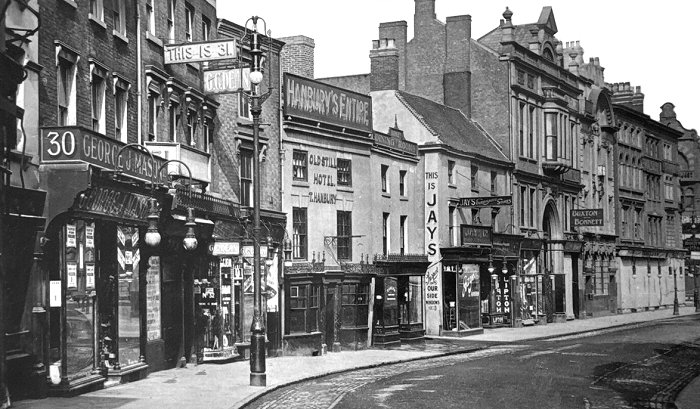
Digbeth. From an old postcard.
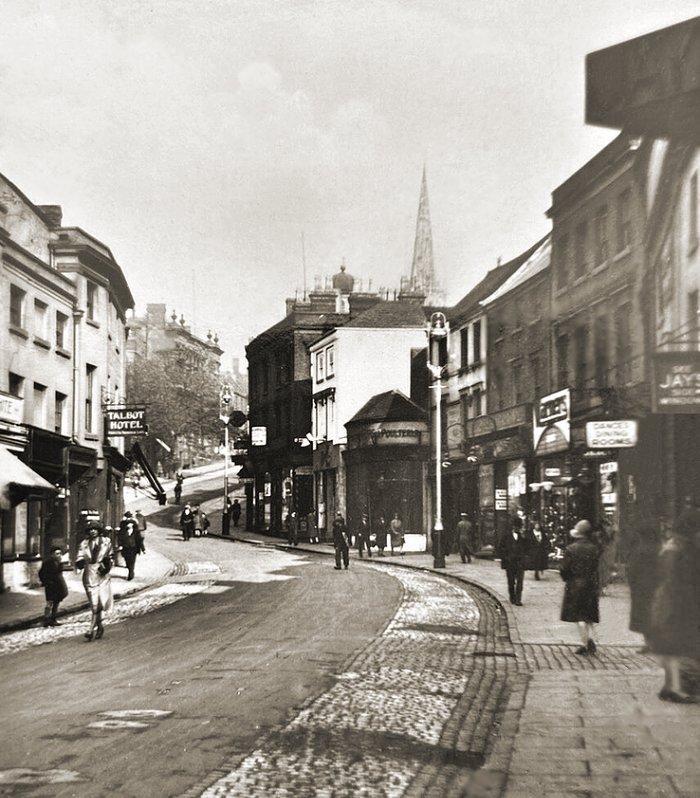
Another view of Digbeth. From an old postcard.
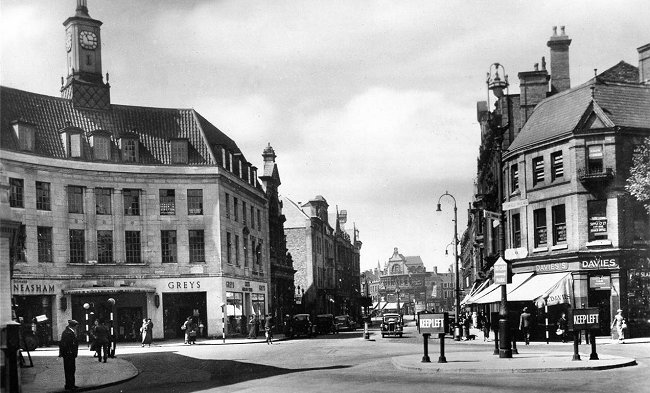
Bridge Street in the 1930s.
| The large Co-operative store
in Bridge Street was a great attraction for local
shoppers. It had a Dairy Department that sold dairy
products including what was described as 'pure, clean
milk', as can be seen from the advert on the right.
|
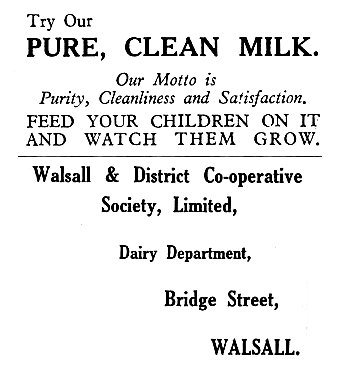 |

A Co-op milk tanker.
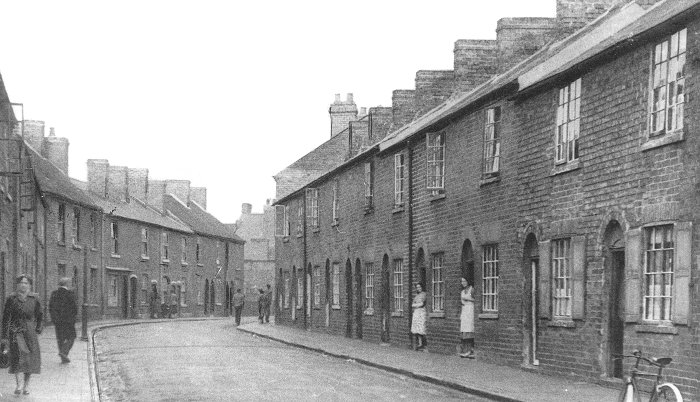
Alfred Street, Bloxwich.
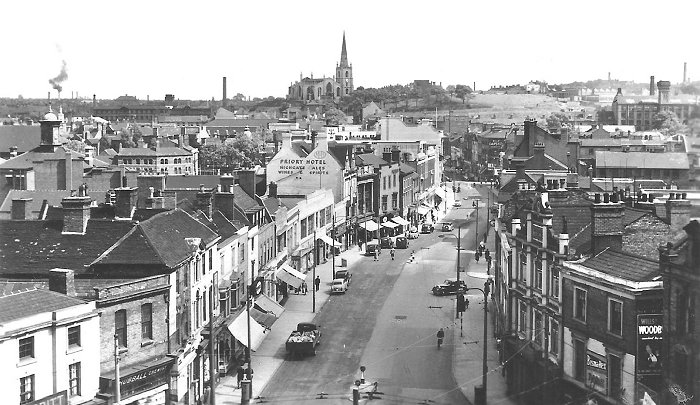
A fine view from the 1950s,
looking along Park Street, to The Bridge and Digbeth.
From an old postcard, courtesy of Christine and John
Ashmore. |
|
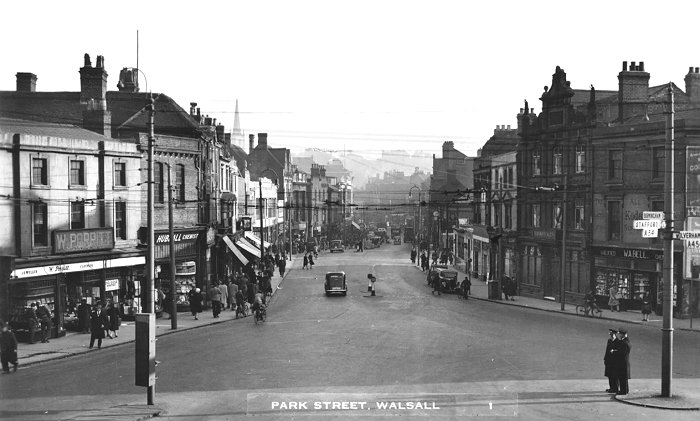
Another view of Park Street
from an old postcard. |
| One national problem that had to be quickly resolved was
the shortage of housing. Housing development ground
to a halt in the late 1930s because of the war. The
population continued to grow at an increasing rate, and
many people were still living in sub-standard houses. To overcome the problem a vast number of council
houses were built in the Borough, including many
single-storey prefabs which were built to last ten
years, although in reality most survived until the mid
1970s.
By 1950 the 10,000th council house had been
completed, at 65 Primley Avenue. It was officially opened
on 3rd June, 1950 by Walsall MP Mr. W. T. Wells.
Over
the next eight years another 5,000 council houses were
built, the 15,000th, at 32 Tintern Way, opened on 17th
November, 1958.
Another 1950s development, the flats in
St Matthew's Close opened in 1953, a year after the
opening of the adjacent Church Hill Memorial Gardens. |
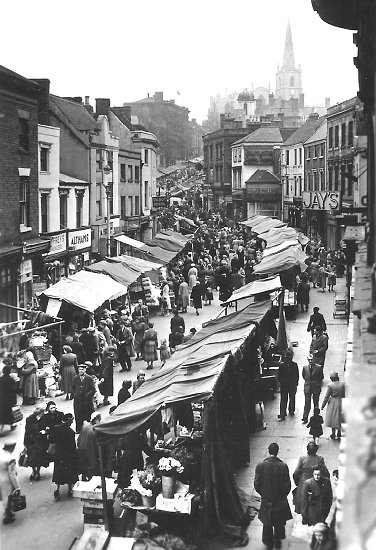
A wonderful photo of Walsall
market in the 1950s. From an old postcard, courtesy of
Christine and John Ashmore. |
|
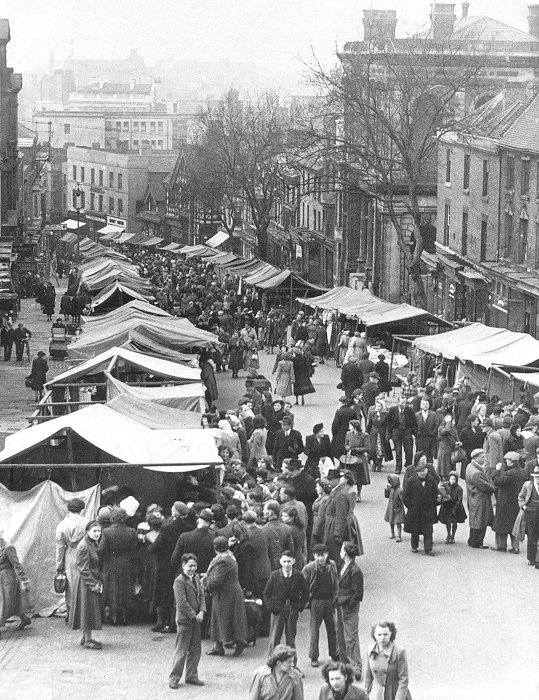
Another view of the market
from the early 1950s. |
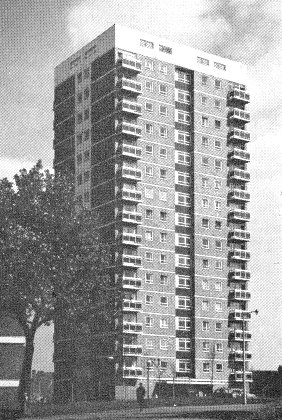
Part of the Sandbank development
between Sandbank and Bell Lane in Bloxwich. |
Multi-storey developments were seen as another answer
to the housing shortage, and so two five storey blocks
were built in Warewell Close, and four eight storey
blocks were built in between Newhall Street and Barleyfield Row in Caldmore. In 1964 an eight and a half acre site with 280
dwellings in multi storey blocks was completed on the
southern side of Leamore Lane, near its junction with
Bloxwich Road. In the 1960s others were
built at Caldmore, the Pleck, Butts Street, Teddesley
Street, Pinfold in Bloxwich, and the Paddock flats off
Union Street. By 1976 there were over 40,000
council-owned properties of all kinds. |
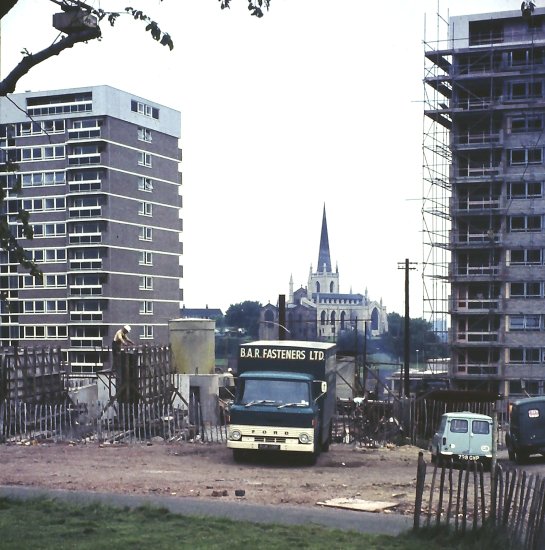
Building the Paddock flats in the
late 1960s. Millsum House is on the left, with Croft
House on the right. Taken by Richard Ashmore. Courtesy of John & Christine Ashmore. |
| In June 1962 an
exhibition of metal products called 'Made In Walsall'
was held at the Central Library and Art Gallery to
celebrate the town's important manufacturing industries.
There were 65 displays covering a wide range of
products from bridleware and stirrups, to tableware,
locks, typewriters, bathroom fittings, electrical goods,
pressings and castings. |
 |
| 1963 saw the opening of the West Midlands College of
Education in Gorway Road. It was originally allied to
Birmingham University's School of Education as a
teachers training college. Several extensions were added
in 1968 including a drama studio, a tutorial building,
and a study building. A library was added in 1971,
followed in 1972 by a dining hall, a medical centre, two
student hostels, staff accommodation, a physical
education building, and a music centre. In 1989 it
became Wolverhampton Polytechnic's Walsall Campus. When
the polytechnic acquired university status, it became
Wolverhampton University's Sports and Art Campus, and
School of Education. |
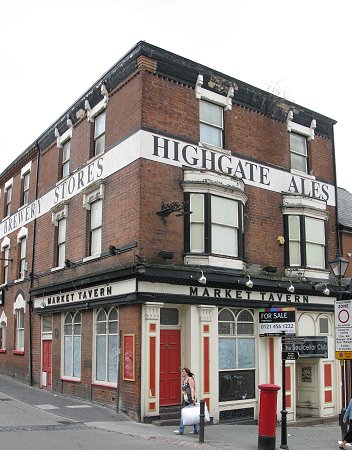 |
|
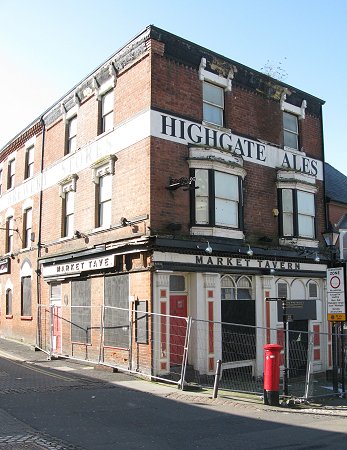 |
|
The sad
looking Market Tavern in High Street in 2013 and
2014. |
|
| 1966 became a significant year
for Walsall as a result of the Local Government Reform
Act. On 1st April the Borough was extended to include
Darlaston, most of Willenhall, and Kings Hill,
previously part of Wednesbury. In 1974 the Borough of
Walsall became a Metropolitan Borough including Aldridge, Brownhills
and Pelsall, with a total population of over 270,000.
Aldridge, which had been merged with Brownhills in 1966 became an
Urban
District in 1894. Brownhills District had been
established as long ago as 1877, and remained as such
until 1894 when it also became an Urban District. |
| |
|
|
|
|
Read a brief
history
of Brownhills |
 |
|
Read a brief
history
of Pelsall |
 |
| |
|
|
|
|
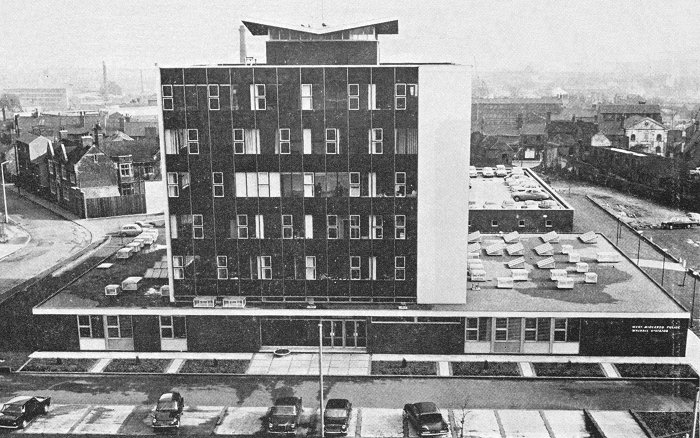
Green Lane police station was
designed as the headquarters for Walsall Borough
Police. It opened operationally on the 19th October,
1966, replacing the former premises in Goodall
Street and High Street. The police station closed in
October, 2016 and has now been demolished. |
|

The new Borough Court in Stafford
Street. |
Following the formation of the Metropolitan Borough, the new Civic Centre in Darwall Street opened in 1976,
and four years later the Saddlers Shopping
Centre and the new railway station opened.
Also in 1976 the
Borough Court moved from the Guildhall to
Stafford Street. It had resided in the Guildhall for 300
years. |
|
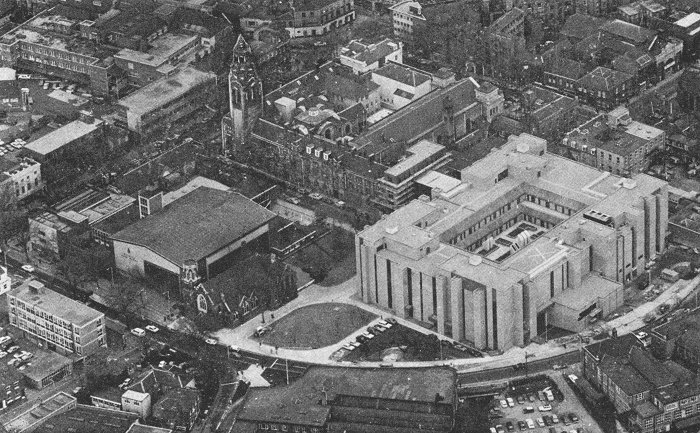
A view of the Civic Centre
from 1976. |
|
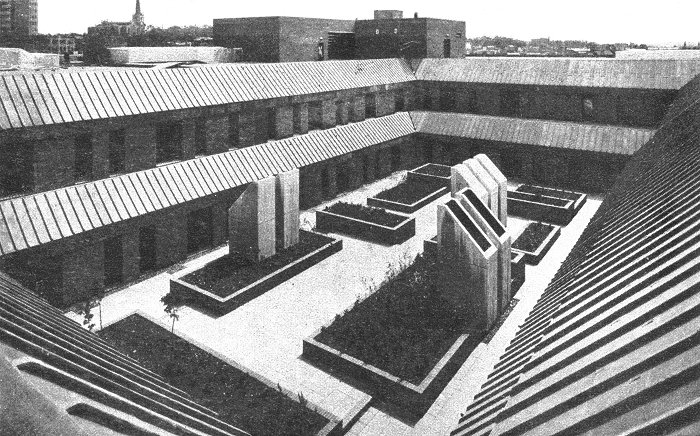
The central court roof garden in
the Civic Centre, as seen in 1976. |
|
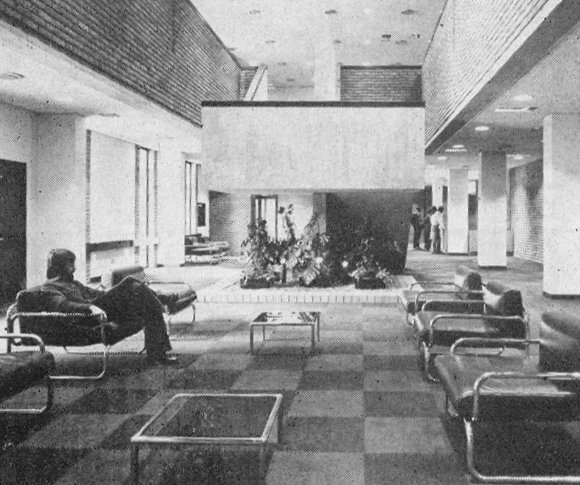
The main reception area in the
Civic Centre. |
The Civic Centre brought the council's main
departments together under one roof. When the building
opened, they were as follows: The offices of the Chief
Executive, and Town Clerks, Housing, Social Services,
Engineering and Town Planning, Architects, Education and
Environmental Health, and the Register Office and
marriage suites. |
| The building initially housed around 1,000 staff, in
135,750 square feet of office space on the four flours. |
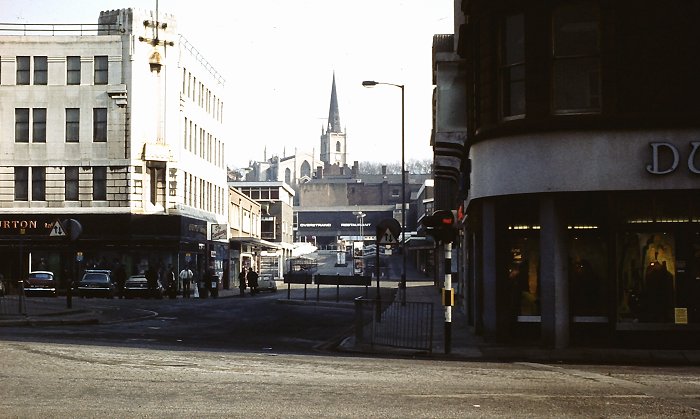
Looking into Digbeth towards
the Overstrand in the mid 1970s. Taken by Richard Ashmore. Courtesy of John & Christine Ashmore. |
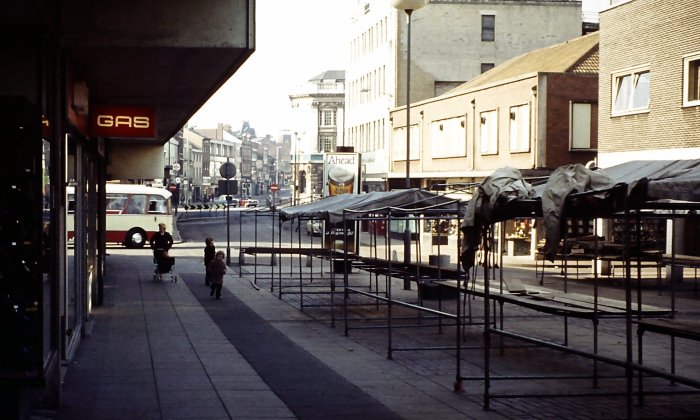
Looking towards Park Street from
Digbeth in the mid 1970s. Taken by Richard Ashmore. Courtesy of John & Christine Ashmore. |

High Street in the mid 1970s on a
none-market day. Taken by Richard Ashmore. Courtesy of John & Christine Ashmore. |
|

The market, as it used to
be. From an old postcard. |
|

A fine view of George Street
in the 1970s. Courtesy of Paul Bowman. |
|
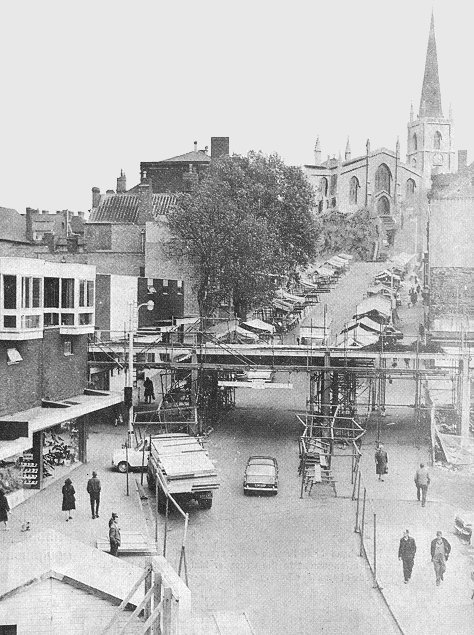
Building the Overstrand in the
late 1960s. |
Sadly Walsall has lost many
of its beautiful old buildings, particularly in Digbeth
and High Street. The mock-Tudor rebuild of the fifteenth
century Woolpack Inn in Digbeth was demolished in August
1966, at the same time as the destruction of most of the
old buildings in High Street.
Initially the
redevelopment included the demolition of the Guildhall
and the Green Dragon, now the Black Country Arms.
Thankfully the plans were amended, and they still
survive as two of the town's loveliest buildings.
Part
of the redevelopment included the building of the
infamous Overstrand which almost divided the street into
two halves, and ruined the lovely view up to the Parish
Church. Many people were delighted when after twenty
years of dereliction, it was demolished in August 2011
to make way for the redevelopment of the area. |
|
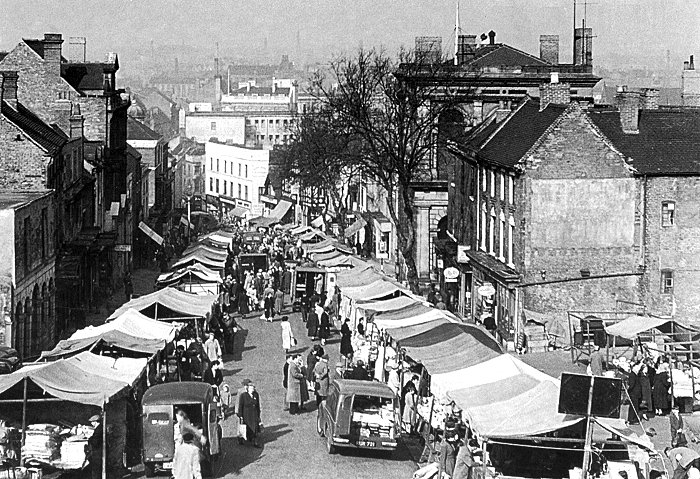
Walsall market in the late
1950s. |
|
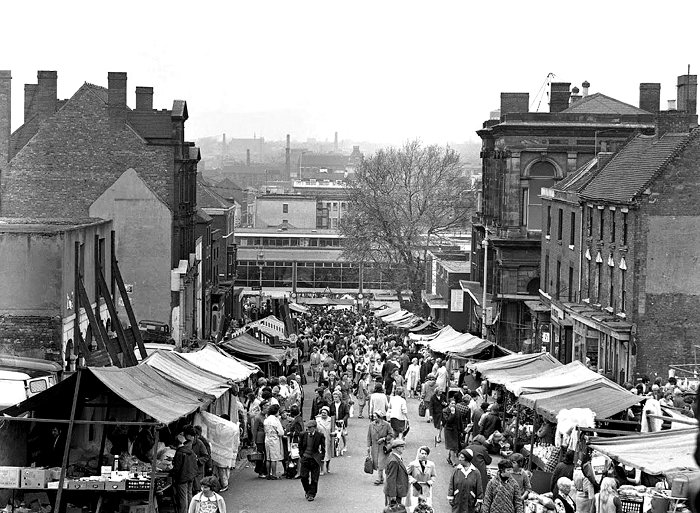
The same view as above, in
the late 1960s. |
|
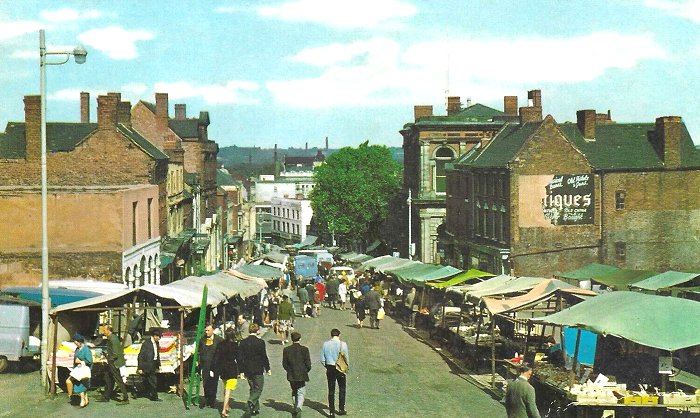
A slightly earlier
image from an old postcard. |
|

The top of the market
in 1962. |
| A more recent loss was the
demolition in 1979 of the fine 1930s Art Deco rebuild of
the old George Hotel on The Bridge, a sad loss to the
town.
Other losses included the Bridge Street
Congregational Church in 1966, and the Wednesbury Road
Congregational Church in 1973, both as a result of
dwindling congregations.
One church success story was
the conversion of St. Paul's Church in the early 1990s
into shops, a cafe, meeting rooms, and a chapel. |
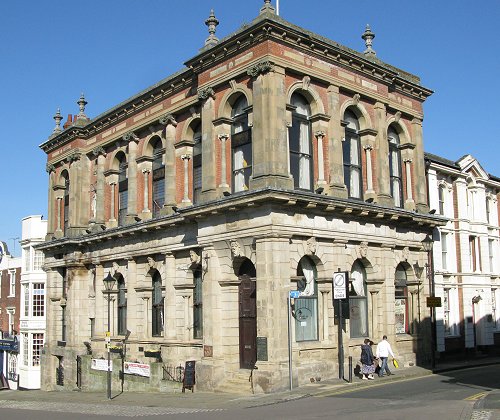
The Guildhall in High Street. |
|
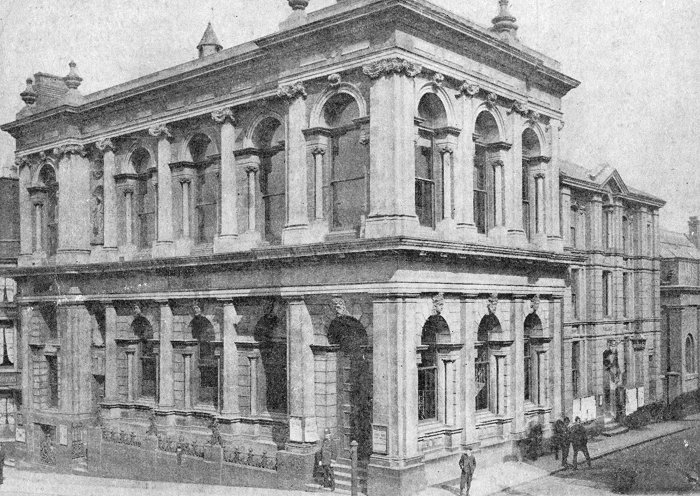
The Guildhall in about 1914. |
|

Park Street. From an old
postcard. |
|
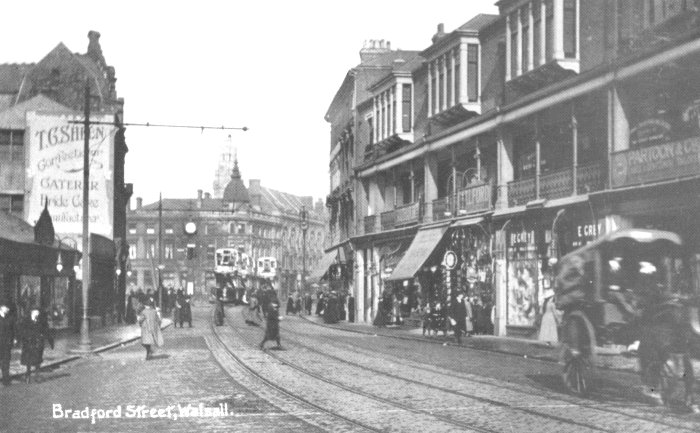
Bradford Street. From an old
postcard. |
| Another success story was the
conversion of Bloxwich Hall in Elmore Green Road into
office accommodation by Rhodes Advertising in 1984. The
building had been neglected for many years, during which
time it was badly vandalised. It had been built in 1830
for Henry Morson, a successful ironmaster, and Grade II
Listed in November 1978. |
|
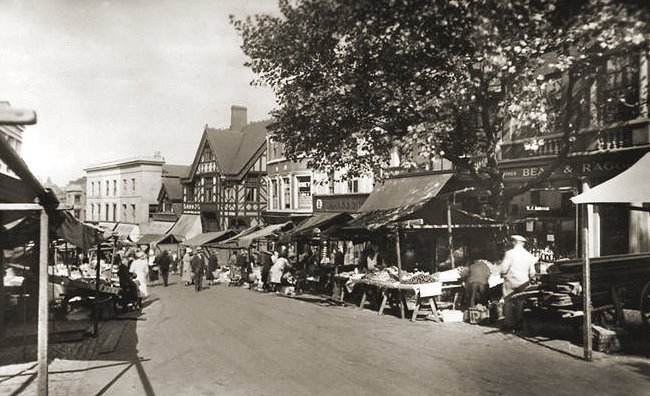
High Street on a busy market
day in the 1950s. From an old postcard. |
|
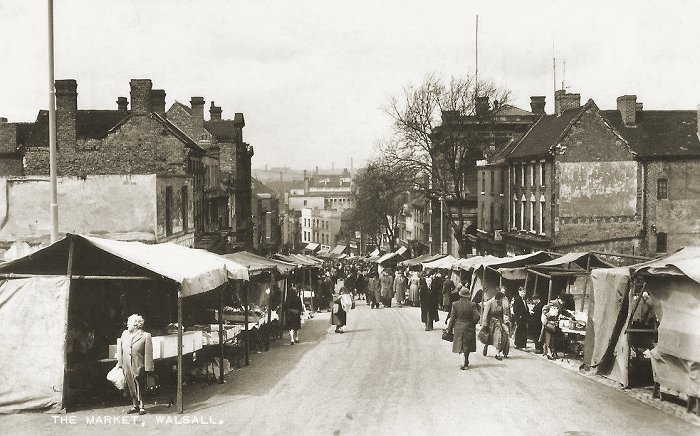
Looking down High Street
into the market. From an old postcard. |
| |
|
View some photos
from
the 1960s and 1970s |
 |
| |
|
|
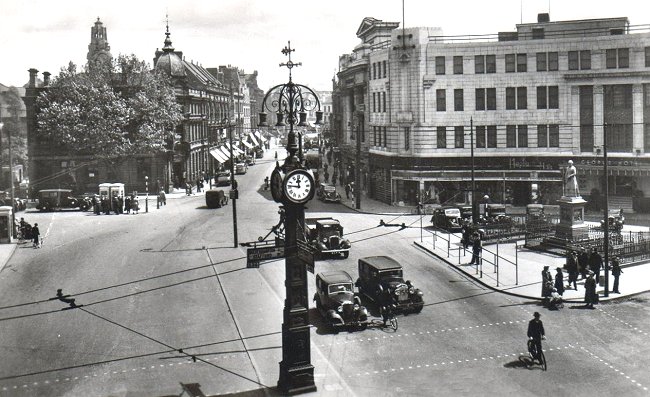
The Bridge with the George
Hotel on the right. |
|

Looking into Park Street.
From an old postcard. |
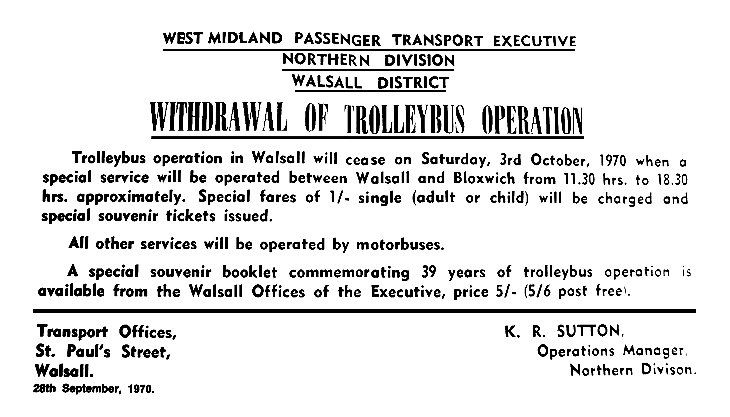
|

Park Street in the early
1970s. Courtesy of Will Parker. |
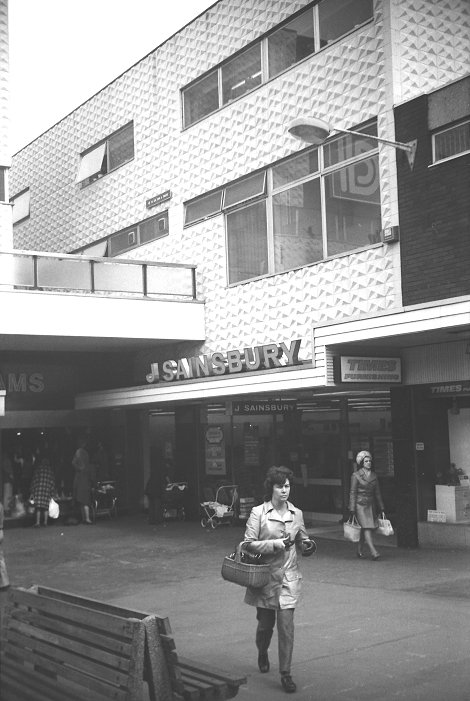 |
Sainsbury's Old
Square store in the early 1970s.
Courtesy of Will
Parker. |
|
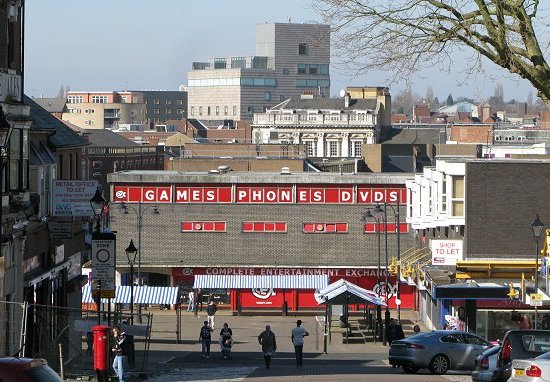
Looking down High Street
towards the Art Gallery. |
 |
|
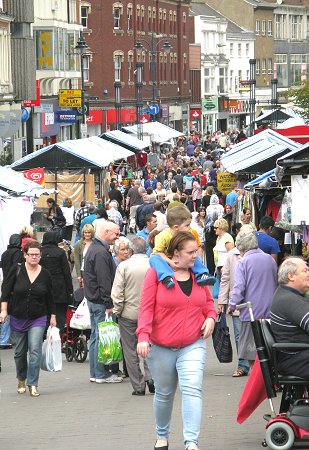 |
|
Two
views of the popular market in 2011. |
|
In 1951, Walsall Illuminations
became an annual event, attracting large numbers of
visitors to the Arboretum to see the spectacular light
show. By the late 1960s the cost of the event had
reached around £10,000, most of which came from
donations. In the mid 1990s over a quarter of a million
people came to see the displays made from over sixty
thousand bulbs. Unfortunately attendances started to
fall, and so in February 2009 Walsall Illuminations
temporarily closed for three years due to financial
constraints. In March 2011 the event was scrapped and
the lights were
sold-off. It had been a popular family attraction, which
will be sadly missed by many children and grown-ups
alike.
| |
|
|
Read the
story of Walsall Arboretum |
 |
| |
|
|
|

A final view of the market. |
|
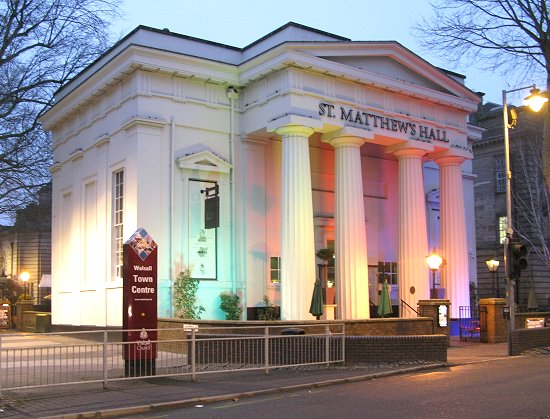
St. Matthew's Hall, now a pub. |

A corner of St. Matthew's Hall, as
seen in June 2017.
|
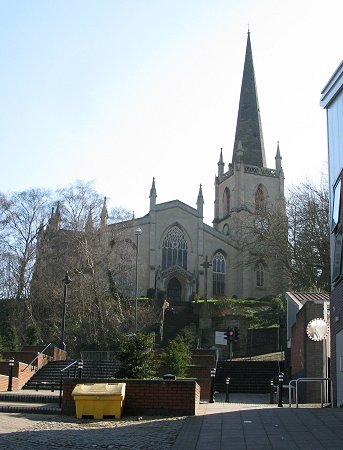
St. Matthew's Church from the top
of High Street. |
By the late 1990s St. Paul's bus
station, built in 1935, and updated in 1970, was
beginning to show its age. In 1998 it was demolished to
make way for the modern bus station which still stands
today. The bus station, costing £6.5 million, was
designed by Allford Hall Monaghan Morris, and built by
Shepherd Construction Limited. It opened in September
2000, and is the terminus for over 85 bus routes.
One of the landmark buildings on
the western side of the town centre is the new art
gallery, designed by Caruso St John. It has
five-storeys and a floor area of 5,000 square
metres. It opened to the public in January 2000, and was officially
opened by the Queen on 5th May, 2000. It houses the
permanent Garman Ryan Collection of sculptures and
paintings by modern masters including a large
selection of work by Jacob Epstein and works by Van Gogh, Monet, Turner, Corot, Renoir and
Constable. The collection was donated to the
people of Walsall in 1973 by Epstein's late wife
Kathleen Garman (Lady Epstein) and her friend Sally
Ryan.
|
|
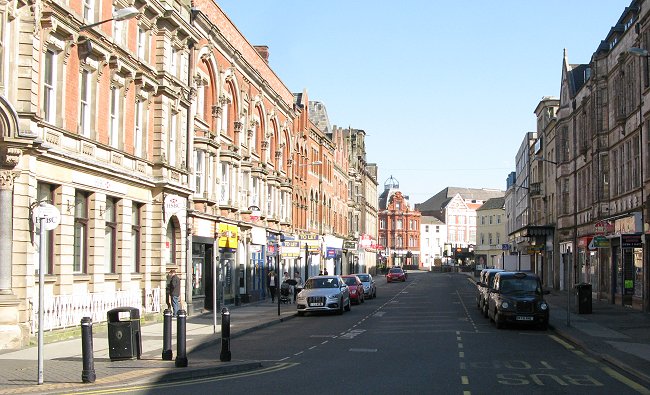
A quiet Sunday in Bridge
Street. |
| In recent years the town has lost some of its
important historical industrial buildings as a
result of mindless arson attacks. |
|
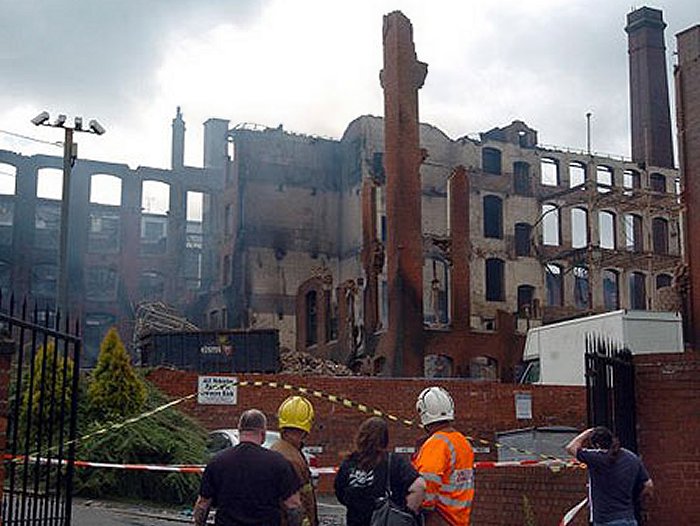
The destruction of
Shannon's Mill. |
|
In August 2007 the
landmark Shannon’s Mill was destroyed in a vast fire,
the worst seen in the Black Country for over twenty five
years. It was built in 1887 and became well known as
John Shannon & Son's clothing factory.
In October 2011 the iconic leather
factory of Jabez Cliff & Company, built in 1870 was
badly damaged and had to be demolished. On
24th July, 2012 the derelict Ravenscraig Works of the
Boak Currying Company Limited, later acquired by
James Garnar & Sons Limited of London, was rapidly
converted into a pile of rubble by a terrible blaze.
Hopefully this trend will not continue.
|

High Street and the Guildhall. |
| Luckily Walsall's town centre
continues to attract large numbers of people who enjoy
the wide variety of shops and amenities. It has faired
reasonably well during the recession, and continues to
attract new investment. Recent projects include the
redevelopment of the Manor Hospital, the new Walsall
College, the developments around the Waterfront, and the
modernisation of roads leading in and out of the town
centre. Hopefully its success will continue, and Walsall
town centre will continue to be popular for generations
to come. |
|
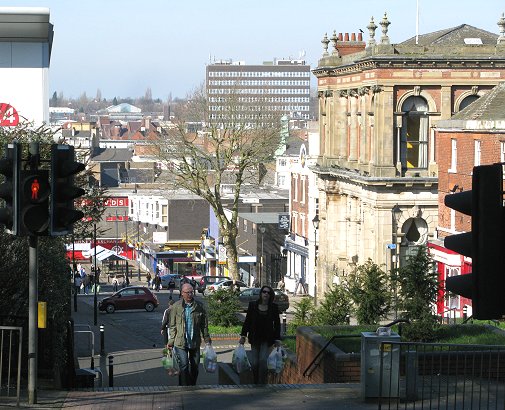
Looking from the top of High Street towards
the market.
|
 |
|
 |
|
 |
Return to World
War Two |
|
Return to
the beginning |
|
Proceed
to
References |
|